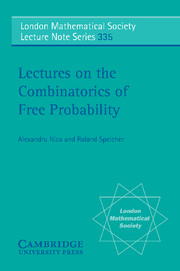Book contents
- Frontmatter
- Contents
- Introduction
- Part 1 Basic concepts
- Part 2 Cumulants
- Part 3 Transforms and models
- Lecture 16 The R-transform
- Lecture 17 The operation of boxed convolution
- Lecture 18 More on the one-dimensional boxed convolution
- Lecture 19 The free commutator
- Lecture 20 R-cyclic matrices
- Lecture 21 The full Fock space model for the R-transform
- Lecture 22 Gaussian random matrices
- Lecture 23 Unitary random matrices
- Notes and comments
- References
- Index
Lecture 21 - The full Fock space model for the R-transform
Published online by Cambridge University Press: 06 July 2010
- Frontmatter
- Contents
- Introduction
- Part 1 Basic concepts
- Part 2 Cumulants
- Part 3 Transforms and models
- Lecture 16 The R-transform
- Lecture 17 The operation of boxed convolution
- Lecture 18 More on the one-dimensional boxed convolution
- Lecture 19 The free commutator
- Lecture 20 R-cyclic matrices
- Lecture 21 The full Fock space model for the R-transform
- Lecture 22 Gaussian random matrices
- Lecture 23 Unitary random matrices
- Notes and comments
- References
- Index
Summary
A convenient fact which was observed and then repeatedly used in the preceding lectures is that one can construct a family of noncommutative random variables with a prescribed joint distribution (where quite often the joint distribution is indicated in the guise of a prescribed joint R-transform). Sometimes there may be more than one way of doing such a construction; an example of such a situation is the one of free semicircular families, which can be obtained by an abstract free product construction, but can also be “concretely” put into evidence by using operators of creation and annihilation on the full Fock space (cf. Lecture 7).
Of course, all the different methods for constructing a family of elements with a prescribed joint distribution are ultimately equivalent, in the respect that the calculations with moments and with cumulants performed on the family give the same results, no matter how the family was constructed. Nevertheless, there can be a substantial difference in the transparency of the calculations – it may happen that the solution to the problem we are trying to solve shows up more easily if one method of construction is used over another.
So this is, in a nut-shell, the idea of “modeling”: find a good way of constructing a family of non-commutative random variables with a given joint distribution, so that we are at an advantage when computing moments and cumulants of that family.
- Type
- Chapter
- Information
- Lectures on the Combinatorics of Free Probability , pp. 339 - 358Publisher: Cambridge University PressPrint publication year: 2006



